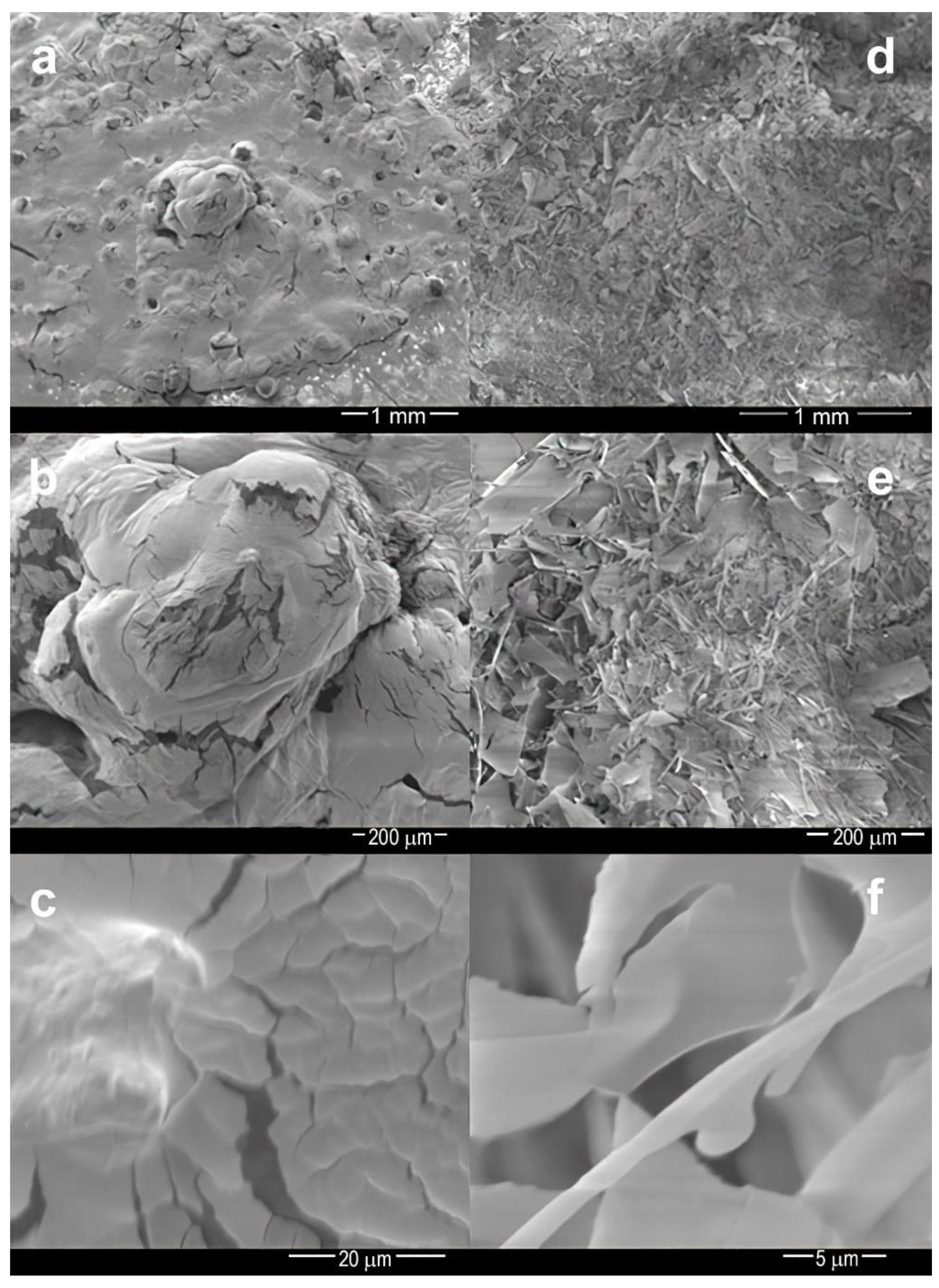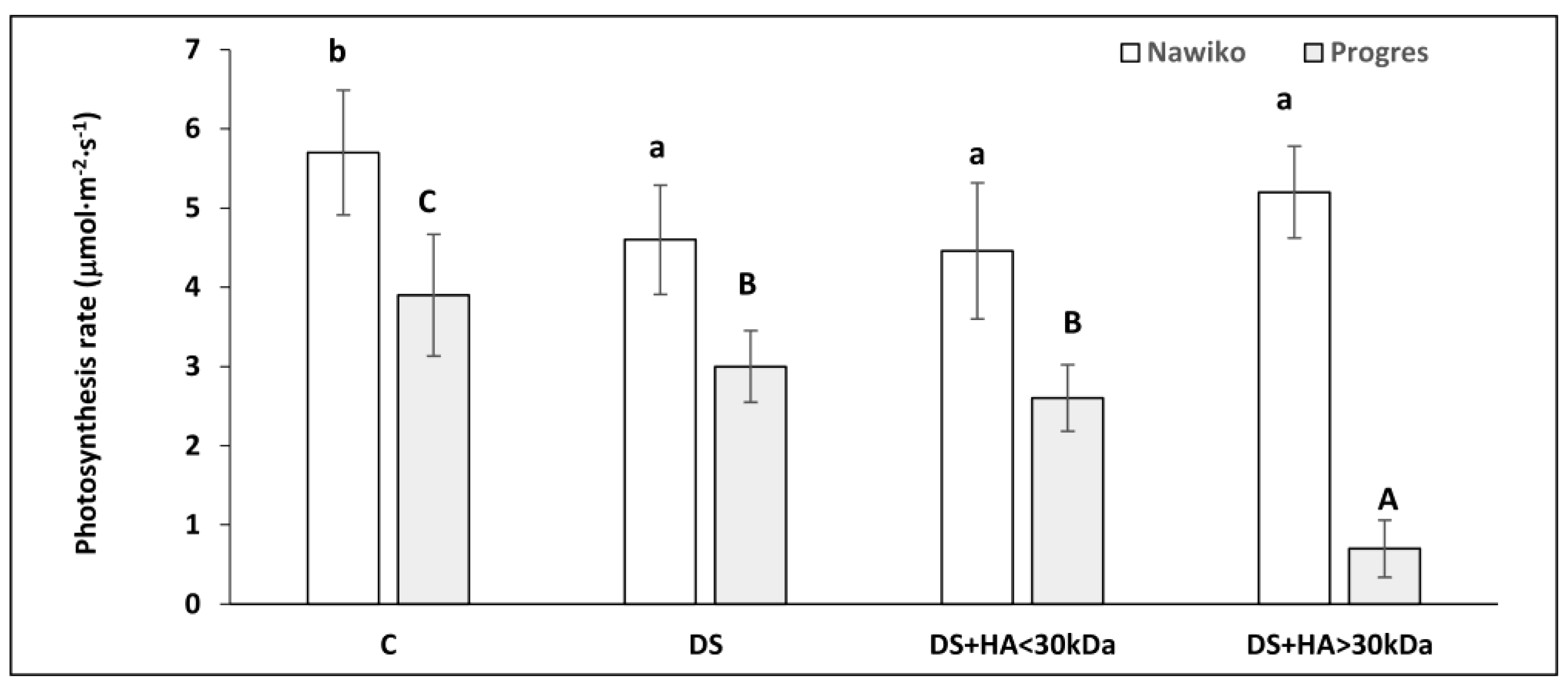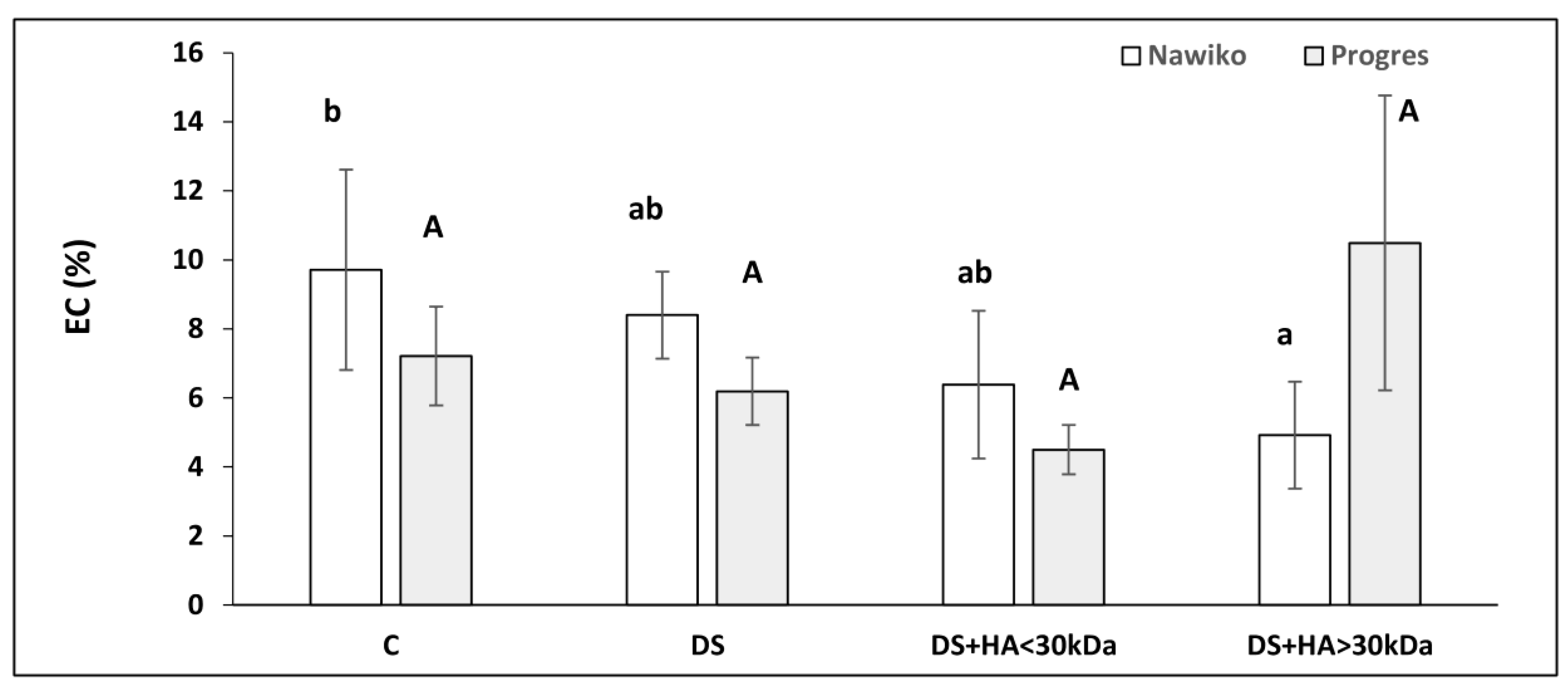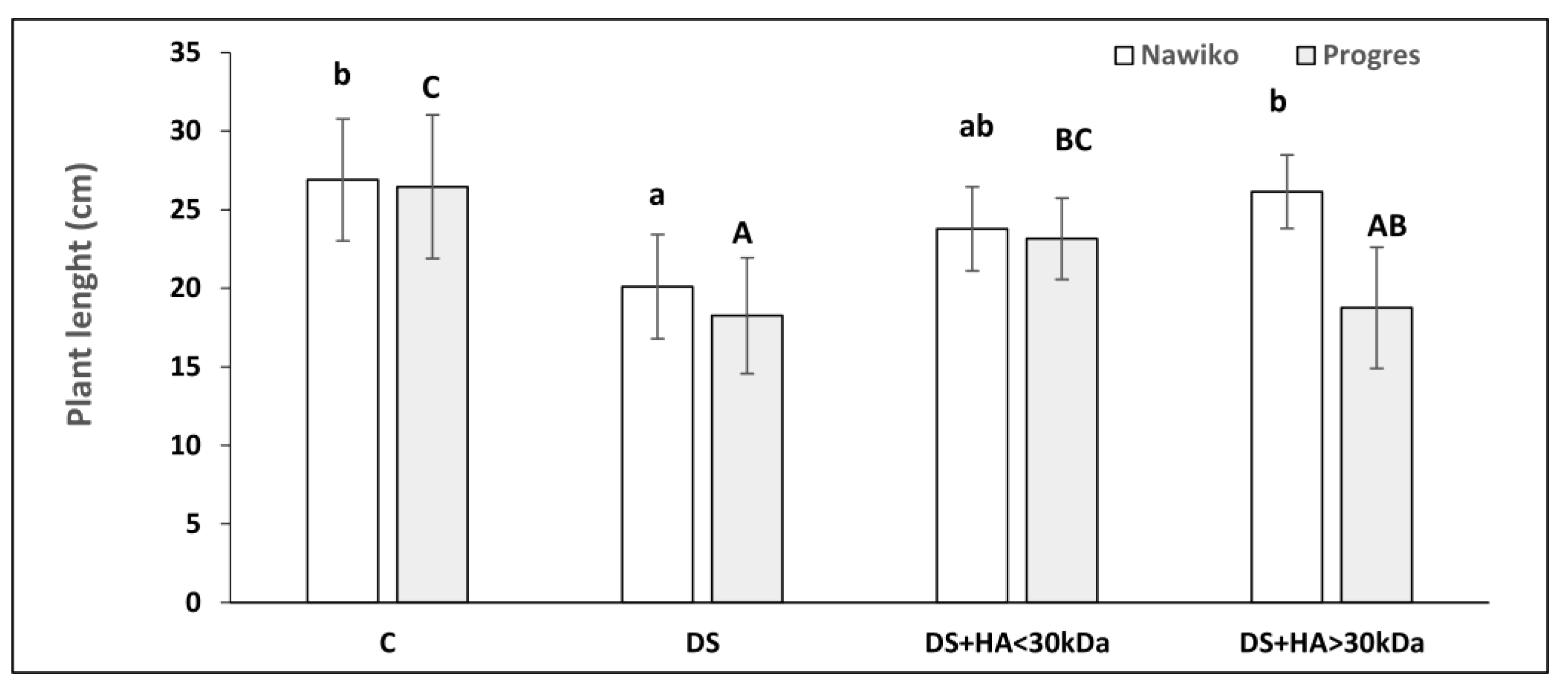Effect of Humic Acids on Soybean Seedling Growth under Polyethylene-Glycol-6000-Induced Drought Stress
Abstract
:1. Introduction
2. Materials and Methods
2.1. Determination of HA Fractions and Their Spectral Characteristic
2.2. Plant Growth Conditions and PEG 6000 Treatment Procedures
- Control (C) (only Hoagland’s solution);
- 0.5 MPa (DS) + Hoagland’s solution;
- 0.5 MPa (DS) + HA < 30 kDa + Hoagland’s solution;
- 0.5 MPa (DS) + HA > 30 kDa + Hoagland’s solution.
2.3. Physiological Measurements
2.3.1. Relative Chlorophyll Content
2.3.2. Photosynthesis Activity
2.3.3. The Relative Electrolyte Leakage
2.4. Biometric Measurements
2.5. Enzyme Measurements
2.6. Ion Measurements
2.7. Statistical Analyses
3. Results and Discussion
3.1. Analysis of HA Fractions’ Properties
3.2. Physiological Measurments
3.3. Biometric Measurements
3.4. Results of Enzyme Activities
3.5. Ion Measurements
4. Conclusions
Author Contributions
Funding
Data Availability Statement
Acknowledgments
Conflicts of Interest
References
- Jańczak-Pieniążek, M.; Buczek, J.; Bobrecka-Jamro, D.; Szpunar-Krok, E.; Tobiasz-Salach, R.; Jarecki, W. Morphophysiology, Productivity and Quality of Soybean (Glycine max (L.) Merr.) cv. Merlin in Response to Row Spacing and Seeding Systems. Agronomy 2021, 11, 403. [Google Scholar] [CrossRef]
- FAOSTAT. Available online: http://www.fao.org/faostat/en/#data/QC (accessed on 18 March 2021).
- Wilk, M. Soya as a source of valuable nutrient. Food Sci. Technol. Qual. 2017, 24, 2, 16–25. [Google Scholar]
- Feng, Z.; Ding, C.; Li, W.; Wang, D.; Cui, D. Applications of metabolomics in the research of soybean plant under abiotic stress. Food Chem. 2020, 310, 125914. [Google Scholar] [CrossRef] [PubMed]
- Qi, D.H.; Lee, C.F. Influence of soybean biodiesel content on basic properties of biodiesel-diesel blends. J. Taiwan Inst. Chem. Eng. 2014, 45, 504–507. [Google Scholar] [CrossRef]
- Graham, P.H.; Vance, C.P. Legumes: Importance and Constraints to Greater Use. Plant Physiol. 2003, 131, 872–877. [Google Scholar] [CrossRef] [PubMed] [Green Version]
- Zou, H.; Zhang, N.-N.; Pan, Q.; Zhang, J.-H.; Chen, J.; Wei, G.-H. Hydrogen sulfide promotes nodulation and nitrogen fixation in soybean—Rhizobia symbiotic system. Mol. Plant Microbe Interact. 2019, 32, 972–985. [Google Scholar] [CrossRef]
- Manavalan, L.P.; Guttikonda, S.K.; Tran, L.S.P.; Nguyen, H.T. Physiological and molecular approaches to improve drought resistance in Soybean. Plant Cell Physiol. 2009, 50, 1260–1276. [Google Scholar] [CrossRef] [Green Version]
- Gao, X.B.; Guo, C.; Li, F.M.; Li, M.; He, J. High Soybean Yield and Drought Adaptation Being Associated with Canopy Architecture, Water Uptake, and Root Traits. Agronomy 2020, 10, 608. [Google Scholar] [CrossRef]
- Starck, Z.; Chołuj, D.; Niemyska, B. Physiological Aspects of Plant Responses to Stress Factors; WULC: Warsaw, Poland, 1995. [Google Scholar]
- Gall, H.L.; Philippe, F.; Domon, J.M.; Gillet, F.; Pelloux, J.; Rayon, C. Cell wall metabolism in response to abiotic stress. Plants 2015, 4, 112–166. [Google Scholar] [CrossRef]
- Talebi, R.; Ensaf, M.H.; Baghebani, N.; Karami, E.; Mohammadi, K.H. Physiological responses of chickpea (Cicer arietinum) genotypes to drought stress. Environ. Exp. Biol. 2013, 11, 9–15. [Google Scholar]
- Matuszak-Slamani, R.; Bejger, R.; Cieśla, J.; Bieganowski, A.; Koczańska, M.; Gawlik, A.; Kulpa, D.; Sienkiewicz, M.; Włodarczyk, M.; Gołębiowska, D. Influence of humic acid molecular fractions on growth and development of soybean seedlings under salt stress. Plant Growth Regul. 2017, 83, 465–477. [Google Scholar]
- Basal, O.; Szabó, A. The Combined Effect of Drought Stress and Nitrogen Fertilization on Soybean. Agronomy 2020, 10, 384. [Google Scholar] [CrossRef] [Green Version]
- Liu, F.; Jensen, C.R.; Andersen, M.N. Drought stress effect on carbohydrate concentration in soybean leaves and pods during early reproductive development: Its implication in altering pod set. Field Crops Res. 2004, 86, 1–13. [Google Scholar] [CrossRef]
- Specht, J.E.; Hume, D.J.; Kumudini, S.V. Soybean yield potential—A genetic and physiological perspective. Crop Sci. 1999, 39, 1560–1570. [Google Scholar] [CrossRef]
- Desclaux, D.; Huynh, T.T.; Roumet, P. Identification of soybean plant characteristics that indicate the timing of drought stress. Crop Sci. 2000, 40, 716–722. [Google Scholar] [CrossRef]
- He, J.; Du, Y.-L.; Wang, T.; Turner, N.C.; Yang, R.-P.; Jin, Y.; Xi, Y.; Zhang, C.; Cui, T.; Fang, X.-W.; et al. Conserved water use improves the yield performance of soybean (Glycine max (L.) Merr.) under drought. Agric. Water Manage 2017, 179, 236–245. [Google Scholar] [CrossRef]
- Basal, O.; Szabo, A. Physiology, yield and quality of soybean as affected by drought stress. Asian J. Agric. Biol. 2020, 8, 247–252. [Google Scholar] [CrossRef]
- Vurukonda, S.S.K.P.; Vardharajula, S.; Shrivastava, M.; SkZ, A. Enhancement of drought stress tolerance in crops by plant growth promoting rhizobacteria. Microbiol. Res. 2016, 184, 13–24. [Google Scholar] [CrossRef]
- Dong, S.; Jiang, Y.; Dong, Y.; Wang, L.; Wang, W.; Ma, Z.; Yan, C.; Ma, C.; Liu, L. A study on soybean responses to drought stress and rehydration. Saudi J. Biol. Sci. 2019, 26, 2006–2017. [Google Scholar]
- Sheteiwy, M.S.; Abd Elgawad, H.; Xiong, Y.C.; Macovei, A.; Brestic, M.; Skalicky, M.; Shaghaleh, H.; Alhaj Hamoud, Y.; El-Sawah, A.M. Inoculation with Bacillus amyloliquefaciens and mycorrhiza confers tolerance to drought stress and improve seed yield and quality of soybean plant. Physiol. Plant. 2021, 172, 2153–2169. [Google Scholar] [CrossRef]
- Farooq, M.; Wahid, A.; Kobayashi, N.; Fujita, D.; Basra, S.M.A. Plant Drought Stress: Effects, Mechanisms and Management. In Sustainable Agriculture; Lichtfouse, E., Navarrete, M., Debaeke, P., Véronique, S., Alberola, C., Eds.; Springer: Dordrecht, The Netherlands, 2009; pp. 153–188. [Google Scholar]
- Fang, Y.; Xiong, L. General mechanisms of drought response and their application in drought resistance improvement in plants. Cell. Mol. Life Sci. 2015, 72, 673–689. [Google Scholar] [CrossRef] [PubMed]
- Rao, D.E.; Chaitanya, K.V. Morphological and Physiological Responses of Seven Different Soybean (Glycine Max L. Merr.) Cultivars to Drought Stress. J. Crop Sci. Biotechnol. 2019, 22, 355–362. [Google Scholar] [CrossRef]
- Ilyas, M.; Nisar, M.; Khan, N.; Hazrat, A.; Khan, A.H.; Hayat, K.; Fahad, S.; Khan, A.; Ullah, A. Drought Tolerance Strategies in Plants: A Mechanistic Approach. J. Plant Growth Regul. 2021, 40, 926–944. [Google Scholar] [CrossRef]
- Ali, F.; Bano, A.; Fazal, A. Recent methods of drought stress tolerance in plants. Plant Growth Regul. 2017, 82, 363–375. [Google Scholar] [CrossRef]
- Ullah, A.; Manghwar, H.; Shaban, M.; Khan, A.H.; Akbar, A.; Usman, A.; Ehsan, A.; Shah, F. Phytohormones enhanced drought tolerance in plants: A coping strategy. Environ. Sci Pollut. Res. 2018, 25, 33103–33118. [Google Scholar] [CrossRef]
- Arslan, E.; Agar, G.; Aydin, M. Humic Acid as a Biostimulant in Improving Drought Tolerance in Wheat: The Expression Patterns of Drought-Related Genes. Plant Mol. Biol. Rep. 2021, 39, 508–519. [Google Scholar] [CrossRef]
- Nardi, S.; Pizzeghello, D.; Muscolo, A.; Vianello, A. Physiological effects of humic substances in higher plants. Soil Biol. Biochem. 2002, 34, 1527–1537. [Google Scholar] [CrossRef]
- Calvo, P.; Nelson, L.; Kloepper, J.W. Agricultural uses of plant biostimulants. Plant Soil 2014, 383, 3–41. [Google Scholar] [CrossRef] [Green Version]
- Van Oosten, M.J.; Pepe, O.; De Pascale, S.; Silletti, S.; Maggio, A. The role of biostimulants and bioeffectors as alleviators of abiotic stress in crop plants. Chem. Biol. Technol. Agric. 2017, 4, 5. [Google Scholar] [CrossRef] [Green Version]
- Fedotov, G.N.; Shoba, S.A.; Fedotova, M.F.; Demin, V.V. On the Probable Nature of Biological Activity of Humic Substances. Eurasian Soil Sci. 2018, 51, 1034–1041. [Google Scholar] [CrossRef]
- Canellas, L.P.; Canellas, N.O.A.; da Silva, S.S.; Irineu, L.E.; Olivares, F.L.; Piccolo, A. Plant chemical priming by humic acids. Chem. Biol. Technol. Agric. 2020, 7, 12. [Google Scholar] [CrossRef]
- Nardi, S.; Schiavon, M.; Francioso, O. Chemical Structure and Biological Activity of Humic Substances Define Their Role as Plant Growth Promoters. Molecules. 2021, 26, 2256. [Google Scholar] [CrossRef]
- Nardi, S.; Muscolo, A.; Vaccaroa, S.; Baiano, S.; Spaccini, R.; Piccolo, A. Relationship between molecular characteristics of soil humic fractions and glycolytic pathway and krebs cycle in maize seedlings. Soil Biol. Biochem. 2007, 39, 3138–3146. [Google Scholar] [CrossRef]
- Asik, B.B.; Turan, M.A.; Celik, H.; Katkat, A.V. Effects of humic substances on plant growth and mineral nutrients uptake of wheat (Triticum durum cv. Salihli) under conditions of salinity. Asian J. Crop Sci. 2009, 1, 87–95. [Google Scholar] [CrossRef] [Green Version]
- Vaughan, D.; Malcolm, R.E. Influence of humic substances on growth and physiological processes. In Soil Organic Matter and Biological Activity; Vaughan, D., Malcolm, R.E., Eds.; Martinus Nijhoff: Dordrecht, The Netherlands, 1985; pp. 37–75. [Google Scholar]
- Berbara, R.L.L.; García, A.C. Humic Substances and Plant Defense Metabolism. In Physiological Mechanisms and Adaptation Strategies in Plants under Changing Environment; Ahmad, P., Wani, M.R., Eds.; Springer: New York, NY, USA, 2014; Volume 1, pp. 298–319. [Google Scholar]
- Muscolo, A.; Sidari, M.; Attiná, E.; Francioso, O.; Tugnoli, V.; Nardi, S. Biological activity of humic substances is related to their chemical structure. Soil Sci. Soc. Am. J. 2007, 71, 75–85. [Google Scholar] [CrossRef]
- Swift, R.S. Organic matter characterization, Chapter 35. In Methods of Soil Analysis: Part 3, Chemical Methods. 5.3; Sparks, D.L., Page, A.L., Helmke, P.A., Loeppert, R.H., Soltanpour, P.N., Tabatabai, M.A., Johnston, C.T., Sumner, M.E., Eds.; American Society of Agronomy: Madison, WI, USA, 1996; pp. 1018–1020. [Google Scholar]
- Munger, P.; Bleihilder, H.; Hack, H.; Hess, M.; Stauss, R.; Van Den Boom, T.; Weber, E. Phenological growth stages and BBCH-identification keys of the soybean (Glycine max L. Merr.). In Growth Stages of Mono and Dicotyledonous Plants; Meier, U., Ed.; BBCH Monograph; Federal Biological Research Centre for Agriculture and Forestry: Quedlinburg, Germany, 2001. [Google Scholar]
- Michel, B.E.; Kaufmann, M.R. The Osmotic Potential of Polyethylene Glycol 6000. Plant Physiol. 1973, 51, 914–916. [Google Scholar] [CrossRef]
- Monje, O.S.; Bugbee, B. Inherent limitations of nondestructive chlorophyll meters: A comparison of two types pf meters. Hortscience 1992, 27, 69–71. [Google Scholar] [CrossRef] [Green Version]
- Dexter, S.T.; Tottingham, W.E.; Graber, L.F. Investigation of the hardiness of plants by measurement of electrical conductivity. Plant Physiol. 1932, 7, 63–78. [Google Scholar] [CrossRef] [Green Version]
- Chance, B.; Machly, A.C. Assay of catalases and peroxidases. In Methods in Enzymology; Colowick, S.P., Kaplan, N.O., Eds.; Academic Press: New York, NY, USA, 1955; pp. 764–775. [Google Scholar]
- Lück, H. Catalase. In Methods of Enzymatic Analysis; Bergmeyer, H.-U., Ed.; Verlag Chemie: New York, NY, USA; London, UK, 1963; pp. 885–888. [Google Scholar]
- Gawlik, A.; Gołębiowska, D.; Kulpa, D.; Bejger, R.; Matuszak-Slamani, R.; Sienkiewicz, M.; Włodarczyk, M. The impact of humic acid fractions on swelling and germination of ‘Progres’ and ‘Nawiko’ soybean seeds under salt and water deficit stresses. Acta Agrobot. 2016, 69, 1672. [Google Scholar] [CrossRef]
- Stevenson, F.J. Humus Chemistry: Genesis, Composition, Reactions; John Wiley and Sons: Hoboken, NJ, USA, 1982; p. 443. [Google Scholar]
- Kumada, K. Chemistry of Soil Organic Matter; Japan Scientific Societes Press: Tokyo, Japan; Elsevier Science: Amsterdam, The Netherlands, 1987; p. 241. [Google Scholar]
- Anjum, S.A.; Xie, X.Y.; Wang, L.C.; Saleem, M.F.; Man, C.; Lei, W. Morphological, physiological and biochemical responnes of plants to drought stress. Afr. J. Agric. Res. 2011, 6, 2026–2032. [Google Scholar]
- Parida, A.K.; Dagaonkar, V.S.; Phalak, M.S.; Umalkar, G.V.; Aurangabadkar, L.P. Alterations in photosynthetic pigments, protein and osmotic components in cotton genotypes subjected to short-term drought stress followed by recovery. Plant Biotechnol. Rep. 2007, 1, 37–48. [Google Scholar] [CrossRef]
- Masoumi, A.; Nabati, J.; Mohammad, K. The influence of drought stress on photosynthetic pigments and some metabolic contents of two Kochia scoparia ecotypes in saline condition. Adv. Bioresearch 2017, 8, 55–61. [Google Scholar]
- Qian, W.; Hu, J.; Zhang, X.; Zhao, L.; Wang, Y.; Ding, Z. Response of Tea Plants to Drought Stress. In Stress Physiology of Tea in the Face of Climate Change; Han, W.Y., Li, X., Ahammed, G., Eds.; Springer: Singapore, 2018. [Google Scholar]
- Wu, Z.; Zhang, Y. Effects of exogenous auxin on physiological and biochemical characteristics of soybean under PEG simulated drought stress. Hubei Agric. Sci. 2019, 58, 16–19, 23. [Google Scholar]
- Kannan, N.D.; Kulandaivelu, G. Drought induced changes in physiological, biochemical and phytochemical properties of Withania somnifera Dun. J. Med. Plants Res. 2011, 5, 3929–3935. [Google Scholar]
- Rao, D.; Chaitanya, K.V. Photosynthesis and antioxidative defense mechanisms in deciphering drought stress tolerance of crop plants. Biol. Plant 2016, 60, 201–218. [Google Scholar] [CrossRef]
- Sourour, A.; Afef, O.; Mounir, R.; Mongi, B.Y. A review: Morphological, physiological, biochemical and molecular plant responses to water deficit stress. Int. J. Eng. Sci. 2017, 6, 1–4. [Google Scholar] [CrossRef]
- Sairam, R.K.; Shukla, D.S.; Saxena, D.C. Stress induced injury and antioxidant enzymes in relation to drought tolerance in wheat genotypes. Biol. Plant 1997, 39, 357–364. [Google Scholar] [CrossRef]
- Ashraf, M.Y.; Azmi, A.R.; Khan, A.H.; Ala, S.A. Effect of Water Stress on Total Phenol, Peroxidase Activity and Chlorophyll Contents in Wheat (Triticum aestivum L.). Acta Physiol. Plant 1994, 16, 185–191. [Google Scholar]
- Jaleel, C.A.; Manivannan, P.; Wahid, A.; Farooq, M.; Somasundaram, R.; Panneerselvam, R. Drought stress in plants: A review on morphological characteristics and pigments composition. Int. J. Agric. Biol. 2009, 11, 100–105. [Google Scholar]
- Nasiri, A.; Sam-Daliri, M.; Shirani-Rad, A.; Mousavi, A.A.; Jabbari, H. The Response of Growth and Yield of Canola Genotypes to Humic Acid Application in Different Plant Densities. Gesunde Pflanz. 2021, 73, 17–27. [Google Scholar] [CrossRef]
- Lotfi, R.; Gharavi-Kouchebagh, P.; Khoshvaghti, H. Biochemical and Physiological Responses of Brassica napus Plants to Humic Acid Under Water Stress. Russ. J. Plant Physiol. 2015, 62, 480–486. [Google Scholar] [CrossRef]
- Tehranifar, A.; Ameri, A. Effect of humic acid on nutrient uptake and physiological characteristics of Fragaria × Ananassa “Camarosa”. Acta Hortic. 2014, 1049, 391–394. [Google Scholar] [CrossRef]
- De Souza, L.T.; de Castro, S.A.Q.; de Andrade, J.F.; Politano, A.A.; Meneghetti, E.C.; Favarin, J.L.; de Almeida, M.; Mazzafera, P. Drought stress induces changes in the physiology and root system of soybean plants. Braz. J. Bot. 2021, 44, 779–789. [Google Scholar] [CrossRef]
- Yordanov, I.; Velikova, V.; Tsonev, T. Plant responses to drought and stress tolerance. Bulg. J. Plant Physiol. 2003, 187–206. [Google Scholar]
- Samarah, N.H.; Alqudah, A.M.; Amayreh, J.A.; McAndrews, G.M. The effect of late-terminal drought stress on yield components of four barley cultivars. J. Agron. Crop Sci. 2009, 195, 427–441. [Google Scholar] [CrossRef]
- Xu, C.; Xia, C.; Xia, Z.; Zhou, X.; Huang, J.; Huang, Z.; Liu, Y.; Jiang, Y.; Casteel, S.; Zhang, C. Physiological and transcriptomic responses of reproductive stage soybean to drought stress. Plant Cell Rep. 2018, 37, 1611–1624. [Google Scholar] [CrossRef]
- Nikinmaa, E.; Hölttä, T.; Hari, P.; Kolari, P.; Mäkelä, A.; Sevanto, S.; Vesala, T. Assimilate transport in phloem sets conditions for leaf gas exchange. Plant Cell Environ. 2013, 36, 655–669. [Google Scholar] [CrossRef]
- Lotfi, R.; Kalaji, H.M.; Valizadeh, G.R.; Khalilvand Behrozyar, E.; Hemati, A.; Gharavi-Kochebagh, P.; Ghassemi, A. Effects of humic acid on photosynthetic efficiency of rapeseed plants growing under different watering conditions. Photosynthetica 2018, 56, 962–970. [Google Scholar] [CrossRef] [Green Version]
- Matuszak-Slamani, R.; Mila, A. Evaluation of cell membrane permeability of barley seedling in conditions of water deficit. Acta Agrophysica 2017, 24, 455–463. [Google Scholar]
- Sun, C.; Gao, X.; Fu, J.; Zhou, J.; Wu, X. Metabolic response of maize (Zea mays L.) plants to combined drought and salt stress. Plant Soil 2015, 388, 99–117. [Google Scholar] [CrossRef]
- Das, A.; Rushton, P.J.; Rohila, J.S. Metabolomic Profiling of Soybeans (Glycine max L.) Reveals the Importance of Sugar and Nitrogen Metabolism under Drought and Heat Stress. Plants 2017, 6, 21. [Google Scholar] [CrossRef] [PubMed] [Green Version]
- Lobato, A.K.D.S.; Neto, C.F.D.O.; Filho, B.G.D.S.; Costa, R.C.L.D.; Cruz, F.J.R.; Neves, H.K.B.; Lopes, M.J.D.S. Physiological and biochemical behavior in soybean (Glycine max cv. Sambaiba) plants under water deficit. Aust. J. Crop Sci. 2008, 2, 25–32. [Google Scholar]
- Khazaei, Z.; Esmaielpour, B.; Estaji, A. Ameliorative effects of ascorbic acid on tolerance to drought stress on pepper (Capsicum annuum L.) plants. Physiol. Mol. Biol. Plants 2020, 26, 1649–1662. [Google Scholar] [CrossRef] [PubMed]
- Bai, X.; Dai, L.; Sun, H.; Chen, M.; Sun, Y. Effects of moderate soil salinity on osmotic adjustment and energy strategy in soybean under drought stress. Plant Physiol. Biochem. 2019, 139, 307–313. [Google Scholar] [CrossRef]
- Rouphael, Y.; Cardarelli, M.; Schwarz, D.; Franken, P.; Colla, G. Effects of Drought on Nutrient Uptake and Assimilation in Vegetable Crops. In Plant Responses to Drought Stress; Aroca, R., Ed.; Springer: Berlin/Heidelberg, Germany, 2012. [Google Scholar]
- Fu, H.; Guo, R.; Shen, W.Y.; Li, M.X.; Liu, Y.; Zhao, M.L.; Wang, X.X.; Liu, X.Y.; Wang, S.Y.; Shi, L.X. Changes in the Metabolome of Two Soybean Genotypes under Drought Stress. Russ. J. Plant Physiol. 2020, 67, 472–481. [Google Scholar] [CrossRef]
- Mora, V.; Baigorri, R.; Bacaicoa, E.; Zamarreño, A.M.; García-Mina, J.M. The humic acid-induced changes in the root concentration of nitric oxide, IAA and ethylene do not explain the changes in root architecture caused by humic acid in cucumber. Environ. Exp. Bot. 2012, 76, 24–32. [Google Scholar] [CrossRef]
- Canellas, L.P.; Olivares, F.L. Physiological responses to humic substances as plant growth promoter. Chem. Biol. Technol. Agric. 2014, 1, 3. [Google Scholar] [CrossRef] [Green Version]
- Manivannan, P.; Jaleel, C.A.; Kishorekumar, A.; Sankar, B.; Somasundaram, R.; Sridharan, R.; Panneerselvam, R. Changes in antioxidant metabolism of Vigna unguiculata L. Walp. by propiconazole under water deficit stress. Colloids Surf. B 2007, 57, 69–74. [Google Scholar] [CrossRef]
- Malenćić, D.; Popović, M.; Miladinović, J. Stress tolerance parameters in different genotypes of soybean. Biol. Plant. 2003, 46, 141–143. [Google Scholar] [CrossRef]
- Telesiński, A.; Smolik, B.; Skrzypiec, N.; Nowak, J. The formation of catalase and peroxidase activity against the background of changes of fluoride content in bean plants after addition of different doses of NaF to soil. Environ. Prot. Nat. Resour. 2009, 41, 219–226. [Google Scholar]
- Olko, A.; Kujawska, M. The dual role of H2O2 in plant responses to stress conditions. Kosmos. Probl. Nauk. Biol. 2011, 60, 161–171. [Google Scholar]
- Mehra, A.; Farago, M.E. Metal Ions and Plant Nutrition. In Plants and the Chemical Elements. Biogeochemistry, Uptake, Tolerance and Toxicity; Farago, M.E., Ed.; VCH: Weinheim, Germany, 1994; pp. 32–59. [Google Scholar]
- Kabata-Pendias, A.; Pendias, H. Biogeochemistry of Trace Elements; PWN: Warszawa, Poland, 1999. [Google Scholar]
- Hu, Y.C.; Schmidhalter, U. Drought and salinity: A comparison of their effects on mineral nutrition of plants. J. Plant Nutr. Soil Sci. 2005, 168, 541–549. [Google Scholar] [CrossRef]








| Cultivar | Combination | Macroelements g·kg−1 (d.m.) | |||
|---|---|---|---|---|---|
| Na ± SD | K ± SD | Mg ± SD | Ca ± SD | ||
| Progres | Control | 1.24 ± 0.08 *a,A | 38.57 ± 1.24 *a,A | 3.63 ± 0.04 *a,A | 9.14 ± 0.46 *a,A |
| DS | 1.30 ± 0.04 a | 36.17 ± 0.75 a | 3.71 ± 0.07 a | 10.40 ± 0.44 b | |
| DS + HA < 30 kDa | 1.81 ± 0.03 b | 37.38 ± 1.29 a | 3.53 ± 0.05 a | 9.97 ± 0.06 b | |
| DS + HA > 30 kDa | 1.61 ± 0.17 b | 32.21 ± 0.27 b | 2.99 ± 0.06 b | 8.10 ± 0.55 a | |
| Nawiko | Control | 2.48 ± 0.30 *a,B | 22.09 ± 0.01 *a,B | 3.50 ± 0.01 *a,A | 8.76 ± 0.31 *a,A |
| DS | 2.16 ± 0.19 a | 21.89 ± 0.13 a | 3.66 ± 0.01 a | 7.97 ± 0.21 b | |
| DS + HA < 30 kDa | 1.14 ± 0.17 b | 21.67 ± 0.30 a | 3.58 ± 0.07 a | 7.84 ± 0.11 b | |
| DS + HA > 30 kDa | 2.56 ± 0.28 a | 25.93 ± 0.67 b | 3.59 ± 0.04 a | 9.01 ± 1.46 a,b | |
| Cultivar | Combination | Microelements mg·kg−1 (d.m.) | ||||
|---|---|---|---|---|---|---|
| Cu ± SD | Mn ± SD | Zn ± SD | Fe ± SD | Co ± SD | ||
| Progres | Control | 16.16 ± 0.12 *a,A | 150.45 ± 3.27 *a,A | 134.75 ± 2.75 *a,A | 317.85 ± 5.80 *a,A | 0.218 ± 0.014 *a,A |
| DS | 13.24 ± 0.15 b | 119.53 ± 2.20 b | 113.58 ± 3.38 b | 117.34 ± 0.48 b | 0.399 ± 0.023 bc | |
| DS + HA < 30 kDa | 12.19 ± 0.63 b | 116.70 ± 6.35 b | 124.21 ± 0.84 c | 85.43 ± 1.17 c | 0.347 ± 0.039 b | |
| DS + HA > 30 kDa | 10.78 ± 0.14 c | 117.63 ± 6.43 b | 103.47 ± 4.15 d | 126.90 ± 3.80 d | 0.422 ± 0.007 c | |
| Nawiko | Control | 12.25 ± 0.31 *a,B | 67.94 ± 2.29 *a,B | 34.72 ± 1.67 *a,B | 164.34 ± 5.07 *a,B | 0.363 ± 0.038 *a,B |
| DS | 11.79 ± 0.04 a | 98.72 ± 1.44 b | 42.49 ± 5.28 b | 166.67 ± 2.93 a | 0.463 ± 0.011 b | |
| DS + HA < 30 kDa | 8.86 ± 0.46 b | 104.43 ± 0.91 b,c | 66.60 ± 3.83 c | 196.84 ± 4.85 b | 0.571 ± 0.058 c | |
| DS + HA > 30 kDa | 9.91 ± 0.33 c | 110.29 ± 2.20 c | 67.20 ± 1.20 c | 185.52 ± 3.13 b | 0.726 ± 0.090 c | |
Publisher’s Note: MDPI stays neutral with regard to jurisdictional claims in published maps and institutional affiliations. |
© 2022 by the authors. Licensee MDPI, Basel, Switzerland. This article is an open access article distributed under the terms and conditions of the Creative Commons Attribution (CC BY) license (https://creativecommons.org/licenses/by/4.0/).
Share and Cite
Matuszak-Slamani, R.; Bejger, R.; Włodarczyk, M.; Kulpa, D.; Sienkiewicz, M.; Gołębiowska, D.; Skórska, E.; Ukalska-Jaruga, A. Effect of Humic Acids on Soybean Seedling Growth under Polyethylene-Glycol-6000-Induced Drought Stress. Agronomy 2022, 12, 1109. https://doi.org/10.3390/agronomy12051109
Matuszak-Slamani R, Bejger R, Włodarczyk M, Kulpa D, Sienkiewicz M, Gołębiowska D, Skórska E, Ukalska-Jaruga A. Effect of Humic Acids on Soybean Seedling Growth under Polyethylene-Glycol-6000-Induced Drought Stress. Agronomy. 2022; 12(5):1109. https://doi.org/10.3390/agronomy12051109
Chicago/Turabian StyleMatuszak-Slamani, Renata, Romualda Bejger, Małgorzata Włodarczyk, Danuta Kulpa, Mariola Sienkiewicz, Dorota Gołębiowska, Elżbieta Skórska, and Aleksandra Ukalska-Jaruga. 2022. "Effect of Humic Acids on Soybean Seedling Growth under Polyethylene-Glycol-6000-Induced Drought Stress" Agronomy 12, no. 5: 1109. https://doi.org/10.3390/agronomy12051109
APA StyleMatuszak-Slamani, R., Bejger, R., Włodarczyk, M., Kulpa, D., Sienkiewicz, M., Gołębiowska, D., Skórska, E., & Ukalska-Jaruga, A. (2022). Effect of Humic Acids on Soybean Seedling Growth under Polyethylene-Glycol-6000-Induced Drought Stress. Agronomy, 12(5), 1109. https://doi.org/10.3390/agronomy12051109









